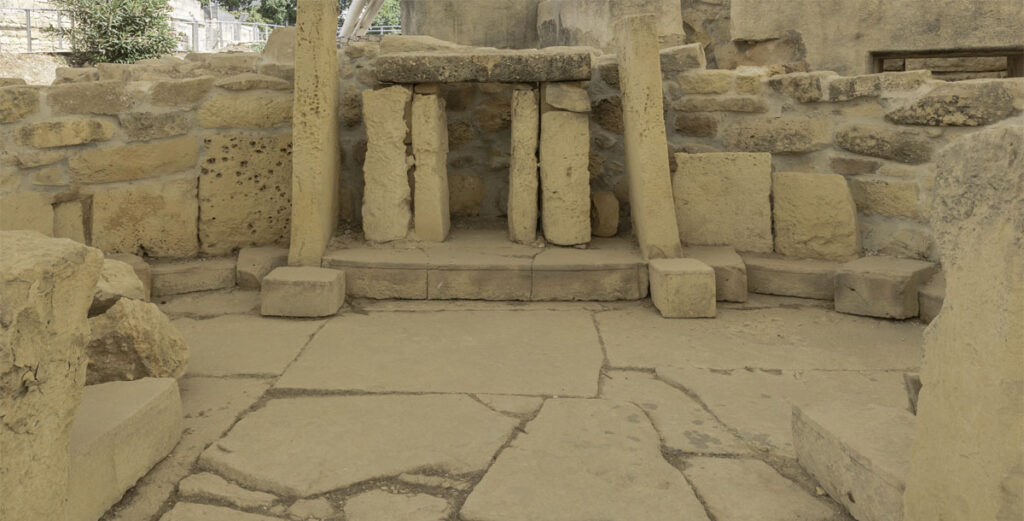
Neolithic Era:
Temples of Malta – A Scientific Breakthrough
At the foot of Sicily are two islands, Malta and Gozo, where more than 23 megalithic temples once stood. The construction of these temples spanned over a thousand years of continuous building and elaboration, from about 3700 BCE until around 2400 BCE.
Today, they are in various states of ruin ranging from a few foundation stones to four amazingly intact temple complexes: Ggantija, Hagar Qim, Mnajdra, and Tarxien, and a fifth subterranean site, Malta’s Ħal-Saflieni Hypogeum.
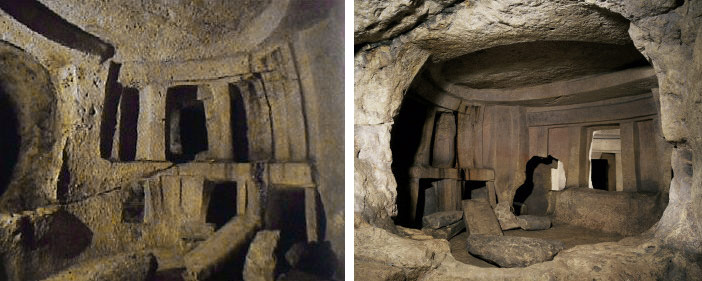
The Ħal-Saflieni Hypogeum is a 3-story underground necropolis and temple of complex chambers. Archeologists estimate that the builders used antler picks, stone hammers, and obsidian blades to work through solid limestone bedrock and remove 2,000 tons of rock to create this cave-like underground temple.
Inside the Hypogeum, the feeling is of being inside a womb. Some of its smoothly finished surfaces are decorated with red-ochre spiral patterns, at times interwoven with a honeycomb pattern similar to those found in Paleolithic cave paintings and associated with one of the three universal stages of the trance state.
Openings seem designed for dramatic lighting. Light plays on the curved walls and spaces in a way that make shapes and shadows seem to be seen then unseen, similar to what is observed in the Paleolithic caves. At the Winter Solstice, light comes in through the main entrance into a ceremonial hall within the heart of the Hypogeum, and on through an elaborately carved chamber into a small room now known as the Holy of Holies that overlooks the burial place for some 7,000 corpses, their bones painted with red ochre.
A most remarkable feature of the Hypogeum is a chamber known as “The Oracle Room” the ceiling of which, according to Glenn Kreisberg, a radio frequency spectrum engineer, “appears to have been intentionally carved into the form of a wave guide.” The experience is extraordinary and otherworldly. A spoken word uttered in a wall niche possesses exceptional acoustic qualities.
The voice is magnified a hundredfold and can be heard throughout the entire structure, echoing for up to 8 seconds. We can imagine the effect when the oracle, god or spirit being spoke and the words came thundering through the dark, mysterious place.
The Paleolithic caves in France and Spain would have included spaces with similar acoustic characteristics, but Ħal-Saflieni marks the earliest example of how our ancestors deliberately used sound to reach alternate states of consciousness, and most likely to affectively instill social cohesion and compliance in the general population. This characteristic would be evident in the later Neolithic structures, such as the Newgrange passage tomb and megalithic cairns. And scholars such as the Emeritus Professor Iegor Reznikoff, specialist in ancient music and acoustic archaeology, suggest that the acoustic nature of Ħal-Saflieni is a link between the Palaeolithic painted caves and Romanesque chapels.
Two contemporary recorded examples of singing by Iegor Reznikoff in styles that showcase the special acoustics of Ħal Saflieni:

One temple has a hidden stairway between rooms, leading archeologists to believe some rooms would have been hidden, presumably reserved for the priesthood. In the other places small “windows” in the walls that link one area inside the temple with another, or with an exterior shrine, are commonly called Oracle Holes. Some scientists think that people would have come to the temple to get questions answered or dreams interpreted by some unseen voice of authority.
Mnajdra South Temple acts as a solar calendar, engineered so that the sun rises directly through the main portal on each Equinox. Imagine what it took to construct and place this monumental building so that it tracked the time for the whole year. The importance of predicting the movement of the constellations obviously went beyond agricultural concerns, though the temple was also the place where surplus food was stored and rationed.
These temples were originally roofed, perhaps with corbelled stones, though no one knows for sure. Vision blocking screens, hidden rooms between walls, oracular openings and restricted access to certain areas, all indicate that these were sacred, secret, and magical places created by the priests and myth-makers. Archeologists can tell from the door fixings evident in some temples that the intention was to keep people out, not in. In other words, entrance and exits were restricted. The keepers of these temple systems had control and they wanted to be sure that they, and no one else, maintained it.
In the documentary, Legacy of a Lost Civilization: Extraordinary People of the Temples of Malta, Dr. David Trump and Richard England state “As the most important structure and the center of the community, the temple was the base of authority. … It was probably a center for food distribution and where surplus was stored. Healthcare, education and worship would all have been part of the function. From the large forecourts and concave stage-like facades, we can imagine that much of the daily activity of the community took place in front of the temple: priests or priestesses stepping forth from the dark interiors to address the crowd from time to time.”
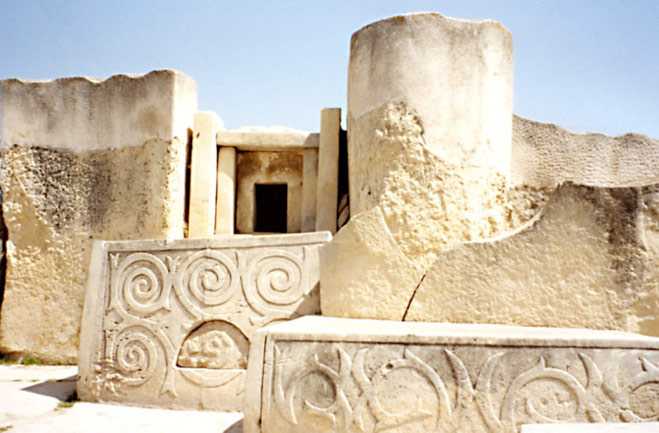
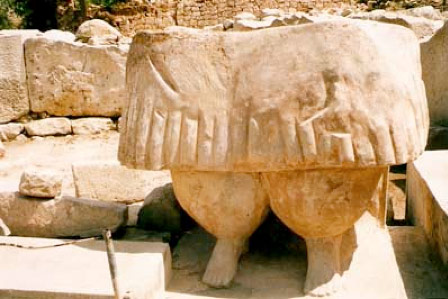

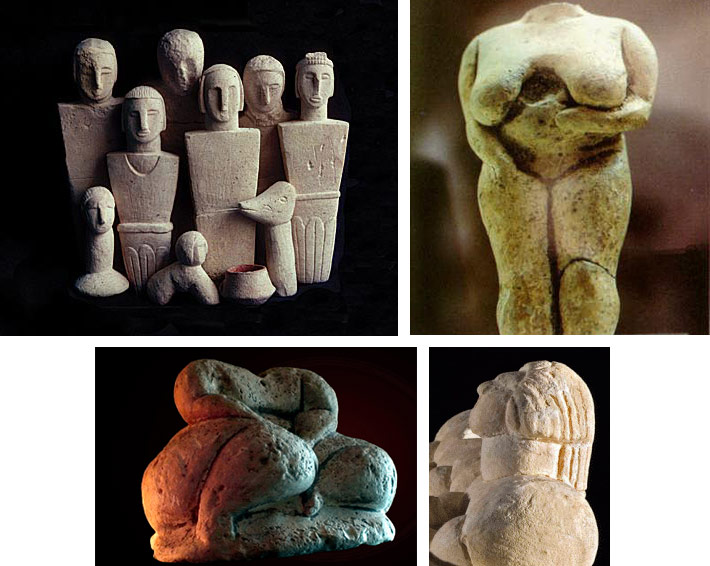
These temples provide evidence that early Neolithic culture included knowledge of architecture, astronomy and audiology a thousand years before the Egyptian pyramids. As people migrated, this knowledge traveled with them, over thousands of years and thousands of miles.
In the series: Neolithic Era
Related articles:
- Mesopotamia: “The Land Between Two Rivers”
- Worldview and Beliefs
- Becoming Human
- Connecting Heaven and Earth
- Early Signs of Monotheism
- Creativity in Response to Crisis
- The Epic of Gilgamesh & Other Writings
- Understanding Their World
- The Use of Sound in Caves
- Connecting with the Spirit World
- The Axemakers Gift: Technology’s Capture and Control of Our Minds and Culture
- Mesopotamia: “The Land Between Two Rivers”
- Worldview and Beliefs
- Connecting Heaven and Earth
- Early Signs of Monotheism
- The Epic of Gilgamesh & Other Writings
- Understanding Their World
- The Noble Ones
- Indus-Sarasvati Civilization
- Mehrgarh 7000–2000 BCE
- Harappa 3500–1900 BCE
- Mohenjo-Daro 2600–1900 BCE
- The Demise of this Great Civilization
- Who Were They and What Did They Believe?
Further Reading
External Stories and Videos
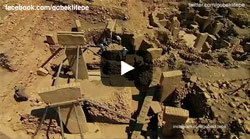
Watch: Göbekli Tepe
BBC
How did the first farmers sustain a large community and build Göbekli Tepe 12,000 years ago?
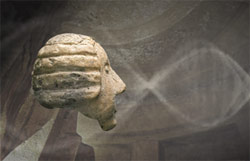
Ancient Architects May Have Been Chasing a Buzz From Sound Waves
The OTS Foundation
“We regard it as almost inevitable that people in the Neolithic past in Malta discovered the acoustic effects of the Hypogeum, and experienced them as extraordinary, strange, perhaps even as weird and “otherworldly.”
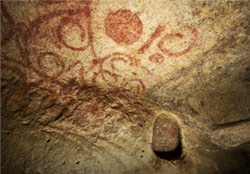
Unveiling an Underground Prehistoric Cemetery
Google Arts and Culture
A look inside Malta’s World Heritage Site, the Ħal Saflieni Hypogeum.
